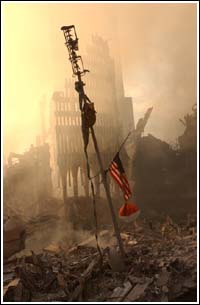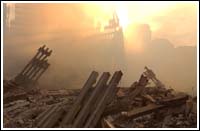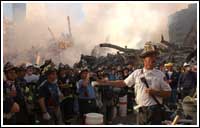General Air Quality/Toxin
Information
Air Monitoring
Fires & Smoke
Fiberglass
Radiation
Worker Safety
Sick Building Syndrome
Particulate Matter/Air Pollution
Bioterrorism
Chemical Exposure Treatment
Misc
Air Monitoring:
Daily Air Quality Reports
(very simplistic, basically only looking at ozone levels. NYC is listed
as "good")
New
York State Ambient Air Monitoring System -- Real time updates of the
NYC area (main
site)
EPA PM2.5 Web
Links -- Photochemical Assessment Monitoring Stations (PAMS) program
Fires & Smoke:
Toxicological
Mechanisms Of Fire Smoke -- The Internet Journal of Rescue and Disaster
Medicine (1998)
"Abstract: Most of the fire victims die or are affected by smoke rather
than by flames and the resulting burns. Asphyxia is the principal mechanism
of the intoxication, mediated by oxygen deprivation, carbon monoxyde inhalation
and sometimes even by hydrocyanic acid inhalation. The other major mechanism
is the inhalation of soot and irritating products of combustion. In this paper
we review the mechanisms of smoke inhalation resulting from the combustion
of some materials present in the modern building, such as mineral fibres,
rigid polyurethane, polystyrene and cellulose fibres.
"The continuing toxicity of smoke may be related to the use of synthetic
polymers as construction materials, for furniture and upholstering. One of
the proximal toxicants is HCN liberated from the nitrogen-containing polymers,
like polyurethane, acrylonitrile-butadiene-styrene copolymer or styrene-acrylonitrile
copolymer. All of them are extensively used in the construction or for the
furniture. Together with CO, CN- ion has been principally implicated in the
death of fire victims."
Grand
Jury Convened to Investigate Seton Hall Dorm Fire -- New York Times,
October 13, 2001 NEW!
"It is the last stage of an investigation that included months of tests
by federal scientists and engineers into the origin of the fire and the reasons
for its searing heat and disorienting black smoke. The smoke quickly filled
a third-floor lounge in Boland Hall, where the fire was started about 4:30
a.m. on Jan. 19, 2000, and then rolled into hallways throughout the dorm.
In a report last June, [Essex County prosecutor, Donald C. Campolo] said investigators
had determined that the blaze was intentionally started when someone set fire
to a paper banner resting on one of three sofas in the lounge. The sofa
contained polyurethane foam, a highly flammable, petroleum-based substance
common in household furniture. Almost immediately after the sofa began
burning, the two nearby sofas erupted in flames and the lounge became an inferno,
filled with blinding smoke, within about five minutes...In the months after
the blaze, Seton Hall officials said the university had corrected all fire-code
violations, installed sprinklers in all dorm rooms and cleared all its buildings
of furniture similar to the polyurethane foam sofas that burned."
Fiberglass:
This site appears to be a good one on fibreglass ... easily read and navigated
... these pages in particular seem appropriate. I'm not knowledgeable enough
to say for certain though. Perhaps someone can check them out and let us know.
http://www.sustainableenterprises.com/fin/basic.htm
http://www.sustainableenterprises.com/fin/House/cleaning.htm
From the same site as previously posted: Need some tips on how to heal your
body after a fiberglass exposure? These commonsense approaches are inexpensive
and natural, and may help.
http://www.sustainableenterprises.com/fin/Health/getbetter.htm
Fiberglass: Use It With Caution!
Published in Environ, #9 (1989), p. 17. by John Bower (Copyright 1989)
http://www.hhinst.com/Artfiberglass.html
Facts about Fiberglass
American Lung Association of Georgia
http://abrannen.home.mindspring.com/alag/fbrglass.htm
Radiation:
Radiation Exposure
from Depleted Uranium Counterweights -- Information on amounts used
in airplanes
Worker Safety:
NIOSH: Protect Your
Family--Reduce Contamination at Home -- Short article on toxics workers
can bring home
The National
Clearinghouse for Worker Safety & Health Training
OSHA Head
Says Rescue Workers' Safety In New York, Pentagon 'Number One Priority'
California Ironworkers
OSHA: Asbestos and
Other Hazards Protection for Rescue Workers
Does not seem to be specific to Sept 11th.
Includes extensive listing of documents on asbestos,
emergency response,
fire safety, protective
equipment, and silica.
Working
Well: A Manager's Guide to Health and Safety in the Workplace
Sick Building Syndrome:
EPA: Indoor Air Facts No.
4 (revised): Sick Building Syndrome (SBS) (April 1991)
Particulate Matter/Air Pollution:
American Lung Association¨
Fact Sheet Particulate Matter Air Pollution
ALA News Conference
On EPA Proposal On Particulate Matter Air Pollution Summary of Findings
American Lung Association
Wind-Borne
Pollutants May Travel Thousands Of Miles -- Texas A&M University
"Air pollution is not just a local problem. In fact, research by geoscientists
at Texas A&M University find that pollutants can travel thousands of miles,
so the air you breathe may contain pollutants brought by the wind...They found
that air pollutants could be transported over long distances instead of being
trapped in the ocean or the soil, and that gaseous water pollutants could
evaporate into the atmosphere instead of staying in the ocean. In both cases,
the airborne pollutants could lead to deposition of pollutants long distances
from where they were produced or used...For example, high levels of pesticides
such as DDT, chlordane and toxaphene are present in beluga whales from the
Arctic, where they were not used...'Our most surprising result is that
there is a flux of contaminants currently coming out of Corpus Christi Bay
to the atmosphere,' Wade says, 'while we previously assumed that all the flux
of contaminants would be into the water.' Wade suggests that PAH might come
from the evaporation from small petroleum spills. 'In an area where we produce
petroleum, there is natural seepage and accidental releases,' he says, 'so
if you spill PAH in the ocean, a lot of it evaporates and then can be transported
long distances.'
"Their research also indicates that DDT and PCB evaporate into the
atmosphere and are transported over long distances. 'Scientists assumed
that when you spray DDT on crops, the insecticides stay in the soil. They
might be washed into rivers when it rains and be transported down rivers to
coastal areas,' Wade says. 'To our surprise, we discovered that the pesticide
can volatilize into the gaseous state and be transported in the air over long
distances fairly rapidly.'"
Bioterrorism:
Are You Prepared
For Bioterrorism? -- Business Week article with (at times odd) commentary
by Joseph M. Mercola, DO.
Center for Disease Control
Answers Questions About Anthrax
Chemical Exposure Treatment:
Agency for Toxic Substances
and Disease Registry Medical Management Guidelines for Acute Chemical Exposures
Misc:
Environmental and Occupational Health Sciences Institute -- Rutgers
University
|
|
|
|
New York City, NY, September 13, 2001
-- The sun streams through the dust cloud over the wreckage of the World
Trade Center. Photo by Andrea Booher/ FEMA News Photo
|
|
|
|
New York City, NY, September 13, 2001
-- The airplane alert antenna sits firmly in the ground amidst the rubble.
Originally it was on the roof of the World Trade Center. Photo by Andrea
Booher/ FEMA News Photo
|
New York City, NY, September 13, 2001
-- A New York City Fire Chief addresses firefighters concerning the
shifting of surrounding buildings at the World Trade Center crash site.
Photo by Andrea Booher/ FEMA News Photo
|
Cyndi Norwitz / webmaster@immuneweb.org
/ Last Modified: 10/22/01


